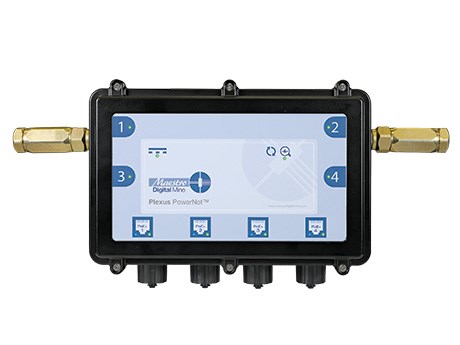Maestro Digital Mine eliminates installation and maintenance challenges
The buzz in the mining industry these days is all about going digital, but installing, extending and maintaining the necessary communication infrastructure underground is time-consuming and expensive.
The problem, according to Michael Gribbons, vice-president of Sudbury-based Maestro Mine Ventilation – recently renamed Maestro Digital Mine – is that most mines have to bring in specialists to terminate fiber-optic cable.
Mine electricians generally don’t work with fiber, but Gribbons and colleague David Ballantyne, vice-president of development and technology, have come up with a solution using co-ax cable and a node called the Plexus PowerNet that simplifies the process.
“Even companies like Vale and Glencore bring in help for this,” said Gribbons. “It’s ridiculous but there are companies that do nothing but fiber terminations. This is what’s limiting (the industry) right now and making it difficult driving infrastructure into the drifts and advancing as the mine advances.
“They’ll run it into their sub-stations, but they don’t have it anywhere else. To do all the things they want to do, they need to run Ethernet out from the substations to the rest of the mine. They’re trying to do it with fiber but they can’t do it affordably or quickly. Getting data from the last mile is the challenge because that’s where the production is.”
Vale’s Thomson operation in northern Manitoba, for example, has to fly someone in from Winnipeg to do fiber terminations, said Gribbons.
Using standard co-ax cable with the Plexus PowerNet node designed by Maestro simplifies the process. The node features colour coded LEDs, so all the electricians need to do is read the lights and understand them.
“I didn’t really think it was that big a deal to be terminating fiber underground, but not having to terminate fiber was the biggest advantage people saw in the product,” said Ballantyne. “It’s not that hard, but mine electricians just don’t want to do it. There’s sort of a built up fear about it. They think it’s a lot harder than it is. You need specialized equipment to do it and it needs to be somewhat clean – cleaner than you’d normally find anywhere in a mine. A lot of time, it needs to be done in a timely fashion if something breaks and it causes downtime.
“Electricians don’t do it every day and it’s a bit of a process, so if you miss a step, it’s a lot more challenging. Also, if they don’t do it regularly, they don’t remember.”
Using Maestro’s co-ax solution, mines are able to get the bandwidth they need to collect data from underground equipment in real time, track personnel and equipment, stream video, and monitor air quality. They can use their own electrical tradesmen to do the terminations and they can get power over the cable, eliminating the need to separately run power, said Gribbons.
The response from the industry has exceeded all expectations.
Of the 20 emails initially sent to customers announcing the solution, 19 responded immediately, said Gribbons.
Barrick’s Cortez Gold Mine in Nevada was the first to purchase the technology, but several other companies have have also expressed interest, he noted.
This isn’t the first time co-ax cable has been used in underground mines.
In the early 90’s, according to Ballantyne, Inco Mines Research used co-ax for the work it was doing on tele-remote mining, but it never took off because each level required hardware that cost several hundred thousand dollars, said Ballantyne. The Plexus node basically does the same thing, but only costs a few thousand dollars, he added.
Earlier this year, Maestro won an Outstanding Achievement in Commercialization Award from the Centre for Excellence in Mining Innovation’s Ultra-Deep Mining Network for its Vigilante Air Quality Station, which is currently being used in more than 70 mines around the world.
“I’ve been told that this is bigger than Vigilante by a long shot,” said Gribbons. “It could double the size of our company in the first year.”



